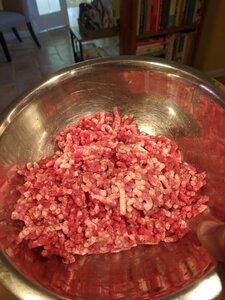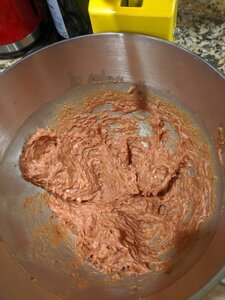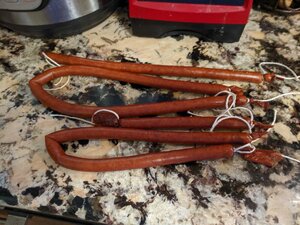Hi folks,
I've been lurking here for a while, scouring the site to try to recreate one of my favorite snack sticks (Ajay's Montana Bananas). I basically went on a mission to find the closest snack stick from my childhood, purchasing any commercial stick I could find. Almost all the sticks were floppy, smooth (without texture), and without "snap." I gather that these are desirable qualities for some folks, but for me, it's not what I want. I should be able to easily break the beef stick in half with three fingers: with the thumb pushing in the center, the stick should snap in half without much effort like a pencil. The casing should be wrinkled and the filler should have texture so that, when you bite into it, you can discern discrete chunks of fat and meat.
After going through 4 packer briskets and doing about 10 batches (each with 2-3 mini experiments), I'm at my wit's end. I could really use anyone's help to come to a solution. In the spirit of sharing tips, and showing my process, here's what I've learned so far:
Thanks!

(Captions for Attached Image)
I've been lurking here for a while, scouring the site to try to recreate one of my favorite snack sticks (Ajay's Montana Bananas). I basically went on a mission to find the closest snack stick from my childhood, purchasing any commercial stick I could find. Almost all the sticks were floppy, smooth (without texture), and without "snap." I gather that these are desirable qualities for some folks, but for me, it's not what I want. I should be able to easily break the beef stick in half with three fingers: with the thumb pushing in the center, the stick should snap in half without much effort like a pencil. The casing should be wrinkled and the filler should have texture so that, when you bite into it, you can discern discrete chunks of fat and meat.
After going through 4 packer briskets and doing about 10 batches (each with 2-3 mini experiments), I'm at my wit's end. I could really use anyone's help to come to a solution. In the spirit of sharing tips, and showing my process, here's what I've learned so far:
- Binders/Additives: I ran through several experiments with different binders and without binders. I tried carrot fiber, phosphates (SureGel, PhosThis!), and milk powder. Binder was helpful when I was first starting out. Early on, I failed to do proper protein extraction, so my sticks were either dry-as-powder or using a form of binder and Okay. I found the phosphates to be a bit aggressive, making my filler smooth (and commercial tasting), but also lacking texture. Ultimately, I feel I got the best texture without using binder at all. Carrot fiber (C-bind) was a very close runner up (and would definitely recommend it in general for beginners). As for additives, I didn't like the tangy taste of Sodium Citrate, so I pulled that out of my mix. I like Sodium Erythorbate since it allows me to get started right away, and it doesn't impact the flavor at all.
- Grind: I ran through different experiments with regard to my grind. The most important (of course) was to have your meat COLD when you grind. After I learned that the hard way, I tried a coarse->fine, medium->fine, coarse-medium, medium two grind, and just medium. I have to say, I don't really see much benefit to multi-grind. Right now, I'm getting results I'm happy with using a single medium (4-6mm grind). I tried several ranges of fat content (80/20, 90/10, 70/30, 60/40), and I was happiest with the standard 80/20. I tried mixing it up with a bit of pork here and there, and it did uniquely affect the flavor, but it wasn't necessary, so I'm sticking with all-beef. I tried with and without beef heart, but as long as you keep the fat/lean ratio the same, it didn't impact it too much (though I do like using a little heart since it add a nice color).
- Flavor / MSG / Liquid Smoke: I was dubious on these, so I ran blind trials with and without each. As long as you don't go overboard on these, I feel they do make things taste better. I use 3g smoke and 3g msg per pound. Add too much of either (esp. smoke) and your snack sticks will go straight to the bin. As for the flavor, I have it pretty dialed in. The key trick I used was to put the seasoning in a coffee grinder first, since the anise/fennel in the pepperoni seasoning was too coarse.
- Technique: I ran an experiment to test whether a slow ramp in cooking temp helped with casing separation (it does, but not as much as proper protein extraction). My schedule is: 1hr@125, 1hr@140, 2hr@155, 4hr@160. I've tried variants of this (lower, shorter, longer, etc...), and nothing worked as well. Another experiment to test cold bath vs. water spray vs. freezer vs. just sticking in the fridge. Water addition after cooking makes the collagen mildly softer, but since I'm trying for crisp, I just stick it in the fridge now. If I figure out this issue, I may revert to a light spray after cooking since it makes the stick easier to bite into, as long as it doesn't make the stick floppy. Another experiment to test whether resting in the fridge helps: my results show it doesn't help as much pre-cook (but I used S. Erythorbate), but it does help tremendously after cook! I think I threw away a few failed experiments too early because I didn't let it stabilize in the fridge long enough. Now, I evaluate all experiments after waiting a day or two in the fridge.
- Casings: I got the 15mm casings from Waltons and I LOVE THEM. They are so much better (and fresher) than the LEMs casings you can get on Amazon. I could tell immediately. This was a big level up for me, once I switched to this casing. The only downside is that they are a bit more fragile, but it's totally worth it. I'm in the process of trying to source 13mm casings, but that's proving difficult...
- Fermentation: I've ruled it out because the sticks I like don't have a tangy flavor at all. Also because the ingredient list doesn't include any fermentables (just beef, beef heart, pepperoni seasoning, sodium erythorbate, liquid smoke, and cure #1).
- I need 13mm casings for this to work. I'm dubious, but maybe this is true given how much better my sticks got when I went from 17mm to 15mm.
- I need to use a smoker. At present, I'm only using a Nesco gardenmaster dehydrator (and the oven if I want to try taking temps up past 160). It makes awesome beef jerky, so I feel I've got that down, but maybe somehow smoke can make it firmer? I don't know...
Thanks!
(Captions for Attached Image)
- Left: What my stick looks like when I try to snap with three fingers.
- Mid: Appearance of the commercial stick after trying to snap with three fingers. This is what I want to achieve.
- Right: Side-by-side cutting a small cross section by knife.
Last edited:







